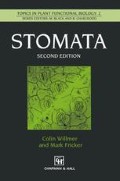Abstract
The story about stomata starts almost 400 million years ago in the late Silurian-early Devonian Period when plants left their aquatic environ- ment and invaded land. In order to survive, the plants had to develop features which would prevent excessive water loss whilst allowing Co2 to enter the plant for photosynthesis. Thus, it is considered that a cuti- cle, stomata and vascular tissue developed almost simultaneously, and these three features were the key to the emergence and development of large terrestrial plants (e.g. Chaloner, 1970).
Access this chapter
Tax calculation will be finalised at checkout
Purchases are for personal use only
Preview
Unable to display preview. Download preview PDF.
References
Alvim, P de T. (1965) A new type of porometer for measuring stomatal opening and its use in irrigation studies. UNESCO Arid Zone Res., 25, 325–329.
van Bavel, C.H.M., Nakayama, F.S. and Ehrler, W.L. (1965) Measuring transpiration resistance of leaves. Plant Physiol., 40, 535–540.
de Candolle, A.P. (1827) Chapter 6, in Organographie Végétale, ou description raisonee des organes des plantes, Vol. 1, Deterville, Paris, pp. 78–88.
de Candolle, A.P. (1832) De l’émanation ou exhalation aqueuse des végétaux vasculaires, in Physiologie végétale, Béchet, Paris, pp. 107–178.
Chaloner, W.G. (1970) The rise of the first land plants. Biol. Rev. Cambridge Phil. Soc., 45, 353–377.
Darwin, F. (1898) Observations on stomata. Phil. Trans. Roy. Soc. Lond., Ser. B, 190, 531–621.
Darwin, F. (1916) On the relation between transpiration and stomatal aperture. Phil. Trans. Roy. Soc. Lond., Ser. B, 207, 413–437.
Darwin, F. and Pertz, D.F.M. (1911) On a new method of estimating the aperture of stomata. Proc. Roy. Soc. Lond., Ser B, 84, 136–154.
Epstein, E. (1972) Mineral Nutrition of Plants: Principles and Perspectives, John Wiley, New York.
Gregory, F.G. and Pearse, H.L. (1934) The resistance porometer and its application to the study of stomatal movement. Proc. Roy. Soc. Lond., Ser. B, 114, 477–493.
Freudenberger, H. (1940) Die Reaktion der Schliesszellen auf Kohlensäure und Sauerstoffentzug. Protoplasma, 35,15–54.
Grew, N. (1682) Anatomy of Plants, London.
Haberlandt, G. (1887) Zur Kenntnis des Spaltöffnungsapparates. Flora, 45, 97–109.
Hales, S. (1727) Vegetable Staticks, London.
Heath, O.V.S. (1948) Control of stomatal movement by a reduction in the normal [CO2] of the air. Nature, 161, 179–181.
Heath, O.V.S. and Mansfield, T.A. (1969) The movement of stomata, in Physiology of Plant Growth and Development, (ed. M. Wilkins), McGraw-Hill, London.
Heath, O.V.S. and Russell, J. (1954) An investigation of the light responses of wheat stomata with attempted elimination of control by the mesophyll. J. Exp. Bot., 5, 1–15, 269–292.
Hedwig, J. (1793) Sammlung seiner zerstreuten, Abhandlungen 1, Crusius, Leipzig, p. 126.
Kanemasu, E.T., Thurtell, G.W. and Tanner, C.B. (1969) Design, calibration and field use of a stomatal diffusion porometer. Plant Physiol., 44, 881–885.
Knight, R.C. (1916) On the use of the porometer in stomatal investigations. Ann. Bot., 30, 57–76.
Kohl, F.G. (1895) Über Assimilationsenergie und Spaltöffnungsmechanik. Botanisches Centralblatt, 64, 109–110.
Kramer, P. (1983) Water Relations of Plants, Academic Press, Orlando, FL.
Linsbauer, K. (1916) Beitrage zur Kenntnis der Spaltöffnungsbewegung. Flora, 9, 100–143.
Lloyd, F.E. (1908) The physiology of stomata. Publ. Carnegie Inst. Wash. 82.
Loftfield, J.V.G. (1921) The behaviour of stomata. Publ. Carnegie Inst. Wash. 314.
Malpighi, M. (1675) Anatome Plantarum, Royal Society, London.
Mclntyre, G. (1994) The role of transpiration in phototropism of the Avena coleoptile. Aust. J. Plant Physiol., 21, 359–375.
Meidner, H. (1987) Three hundred years of research into stomata, in Stomatal Function, (eds E. Zeiger, G.D. Farquhar and I.R. Cowan), Stanford University Press, Stanford, CA, pp. 7–27.
Meidner, H. and Mansfield, T.A. (1968) Physiology of Stomata, McGraw Hill, London.
von Mohl, H. (1856) Welche Ursachen bewirken die Erweiterung und Verengung der Spaltöffnungen? Bot. Ztg., 14, 697–704, 713–720.
Müller, N.J.C. (1870) Über den Durchgang von Wasserdampf durch die geschlossene Epidermiszelle. fahrb. Wissenschaft. Botanik, 7, 193–199.
Müller, N.J.C. (1872) Die Anatomie und die Mechanik der Spaltöffnungen, Jahrb. Wissenschaft. Botanik, 8, 75–116.
Nobel, PS. (1991) Physicochemical and Environmental Plant Physiology, Academic Press, San Diego, CA.
Scarth, G.W. (1929) The influence of H-ion concentration on the turgor and movement of plant cells with special reference to stomatal behaviour. Proc. Int. Conf. Plant Sci., 2, 1151–1162.
Schwendener, S. (1881) Über Bau und Mechanik der Spaltöffnungen. Monatsberichte der Königlichen-Preusssischen Akademie der Wissenschaften zu Berlin, Physikalisch-mathematische Klasse, pp. 833–867.
Slatyer, R.O. and Jarvis, P.G. (1966) Gaseous diffusion porometer for continuous measurement of diffusive resistance of leaves. Science, 151, 574–576.
Tanner, W. and Beevers, H. (1990) Does transpiration have an essential function in long-distance ion transport in plants? Plant Cell Environ., 13, 745–750.
Wallihan, E.F. (1964) Modification and use of an electrical hygrometer for estimating relative stomatal aperture. Plant Physiol., 39, 86–90.
Wilkins, M.B. (1993) The role of stomata in the generation of circadian rhythms in plant tissues.J. Exp. Bot. Suppl., 44, 2.
Williams, T. (1841) On the structure and uses of the stomata. Microscopic J. Struct. Record, 1, 118–121.
Wilson, C.C. (1947) The effects of some environmental factors on the movements of guard cells. Plant Physiol., 23, 5–37.
Zelitch, I. (1963) The control and mechanism of stomatal movements, in Stomata and Water Relations in Plants (Connecticut Experimental Station Bull. 664), Newhaven, CT, pp. 18–36.
Author information
Authors and Affiliations
Rights and permissions
Copyright information
© 1996 Colin Willmer and Mark Fricker
About this chapter
Cite this chapter
Willmer, C., Fricker, M. (1996). Introduction. In: Stomata. Springer, Dordrecht. https://doi.org/10.1007/978-94-011-0579-8_1
Download citation
DOI: https://doi.org/10.1007/978-94-011-0579-8_1
Publisher Name: Springer, Dordrecht
Print ISBN: 978-94-010-4256-7
Online ISBN: 978-94-011-0579-8
eBook Packages: Springer Book Archive

